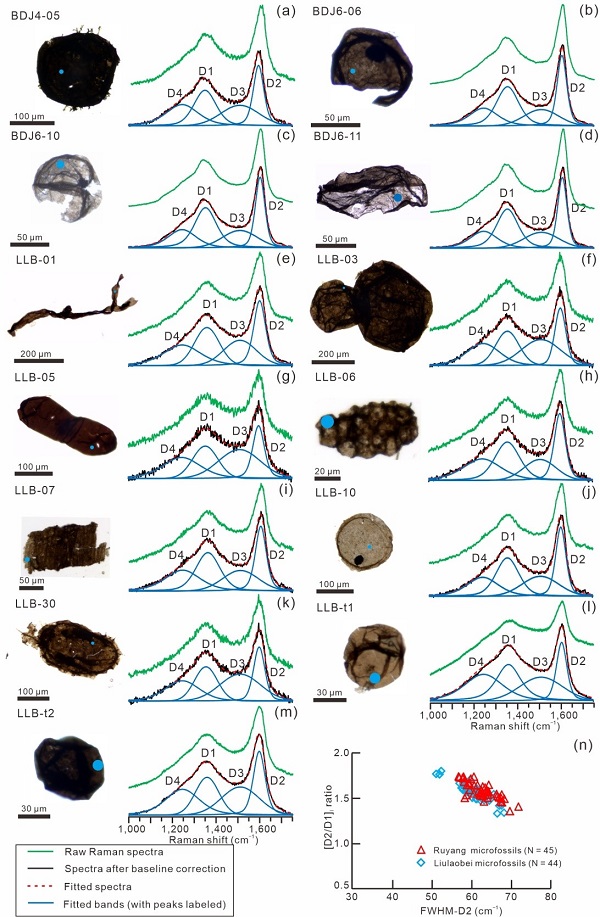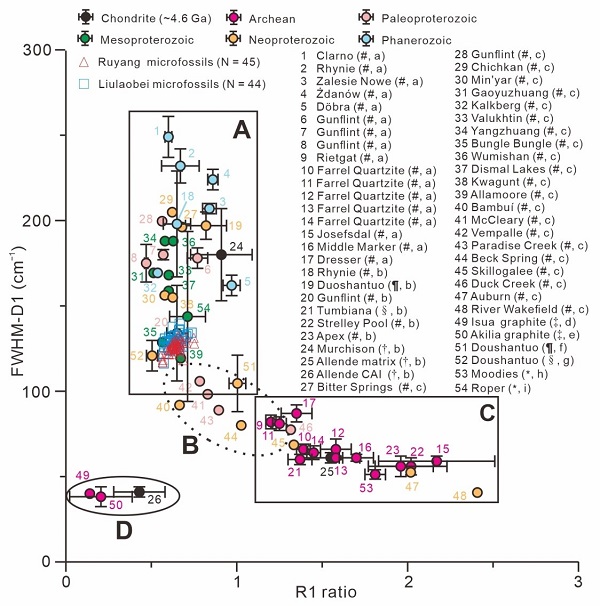Raman spectroscopy, including spot, line, and mapping analyses with Raman spectrometer, has been widely used in the structural characterization of carbonaceous material (CM) in the past few decades. It is a minimally intrusive and minimally destructive technique that has played an important role in analyzing Precambrian materials, including putative microfossils, three-dimensionally permineralized microfossils, and organic-walled microfossils preserved in fine-grained siliciclastic rocks. Various Raman spectral parameters have also been proposed as geothermometers to unveil the thermal history of CM during burial and metamorphism. Previous studies have shown that heterogeneities in structural order of carbonaceous material (CM) as revealed by Raman spectroscopy can be preserved in Proterozoic silicified cyanobacterial fossils. However, such heterogeneities have not been documented in Proterozoic eukaryotic microfossils preserved as carbonaceous compressions.
A team of scientists led by Dr. PANG Ke from Nanjing Institute of Geology and Palaeontology, Chinese Academy of Sciences (NIGPAS) and Dr. Qing Tang from Virginia Tech used Raman spectroscopy to investigate the structural characteristics of organic-walled microfossils, including eukaryotes preserved as carbonaceous compressions, from the late Paleoproterozoic Ruyang Group and the early Neoproterozoic (Tonian) Liulaobei Formation in the North China Craton. Well-preserved eukaryotic microfossils, including Dictyosphaera delicata, Shuiyousphaeridium macroreticulatum, Leiosphaeridia jacutica, and Leiosphaeridia tenuissima, from two horizons in these stratigraphic units were analyzed and compared. Related results have been recently published in the geoscience academic journal Precambrian Research.
Their goal in this study was to document CM Raman structural heterogeneities in Proterozoic organic-walled microfossils and to explore their implications for CM Raman geothermometry, the preservation of different organic precursors, morphology-based taxonomy, and biological affinity.
Raman geothermometers indicate that CM experienced low-grade metamorphism with apparent peak metamorphic temperatures of ~200 °C for both the Ruyang and Liulaobei microfossils. Heterogeneities in structural characteristics of CM in eukaryotic microfossils were found among different subcellular structures of Shuiyousphaeridium macroreticulatum and among different taxa from the same stratigraphic horizon. The scientists suggest that these heterogeneities can be attributed to differences in precursor organic compounds; thus, the importance of organic precursors should be considered in CM Raman geothermometry studies, especially in environments where heating events occurred quickly.
The Raman data presented in this study are also consistent with hypotheses that the Ruyang microfossils Dictyosphaera delicata and S. macroreticulatum are biologically conspecific taxa with their vesicle walls having similar CM Raman features, and that the Liulaobei microfossils Leiosphaeridia jacutica and L. tenuissima are distinct taxa despite their similarities in morphologies other than vesicle wall thickness.
Although more data are needed to verify the consistency of interspecies, intraspecies, and intraspecimen variability, this study indicates that Raman spectroscopy may have the potential to provide an independent test of early eukaryote taxonomy, which has been traditionally based only on morphological features, and to reveal heterogeneities of CM of early eukaryotic organisms.
This research was supported by the National Natural Science Foundation of China, Chinese Academy of Sciences, National Key Research and Development Program of China, State Key Laboratory of Palaeobiology and Stratigraphy, and Natural Science Foundation of Jiangsu Province of China.
Reference: Pang, K.#*, Tang, Q.#, Wu, C., Li, G., Chen, L., Wan, B., Yuan, X., Bodnar, R.J., Xiao, S.* Raman Spectroscopy and structural heterogeneity of carbonaceous material in Proterozoic organic-walled microfossils in the North China Craton. Precambrian Research, 2020, 346: 105818. https://doi.org/10.1016/j.precamres.2020.105818.

Representative Raman spectra of organic-walled microfossils from the late Paleoproterozoic Ruyang Group and the early Neoproterozoic (Tonian) Liulaobei Formation in the North China Craton

Summary plots showing evolutionary trend of R1 ratio vs. FWHM-D1 based on Raman spectra from the literature and from the Ruyang and Liulaobei microfossils
Download:
